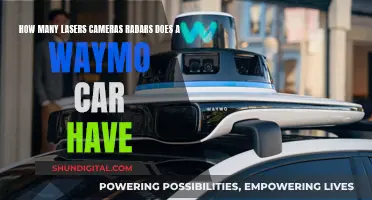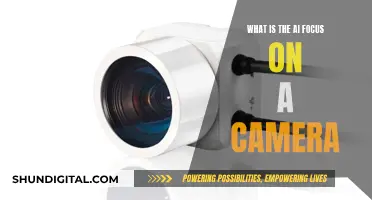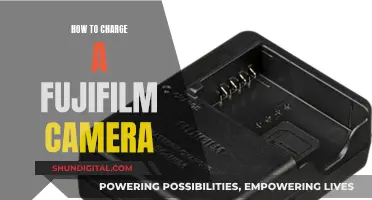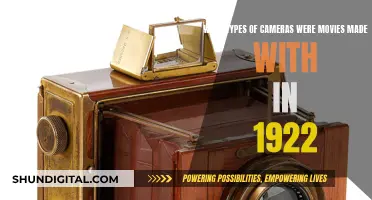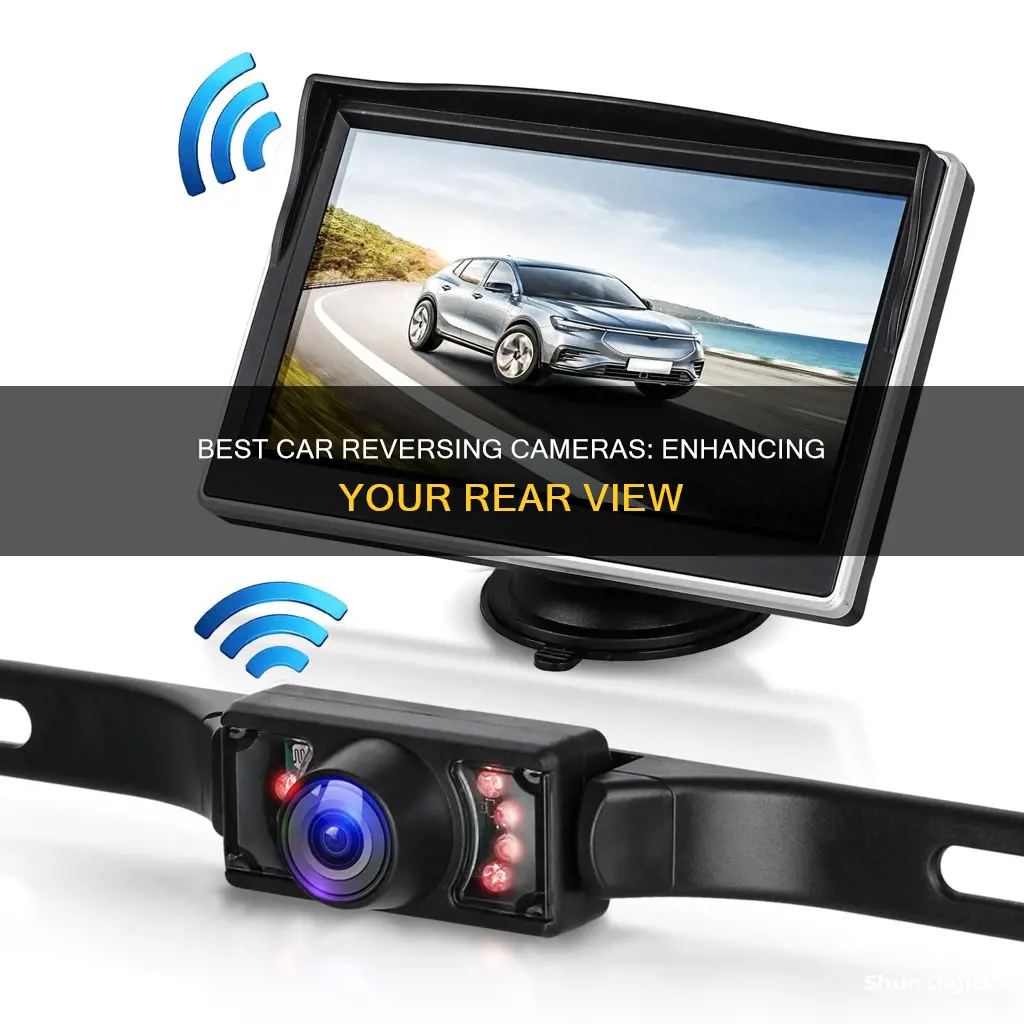
A car reversing camera, also known as a backup camera, is a video camera that is typically mounted on the rear of a vehicle, pointed backward. It provides a clear view of the area behind the vehicle, helping to prevent accidents while reversing or parking. Since 2018, all new cars have been legally required to have reversing cameras installed. However, if you have an older car, you can purchase an aftermarket camera to install yourself. There are several types of reversing cameras available, including wired, wireless, and smartphone cameras, as well as different features such as night vision and wide-angle lenses. When choosing a reversing camera, it's important to consider factors such as ease of installation, price, and compatibility with your vehicle.
| Characteristics | Values |
|---|---|
| Camera Mount Location | License Plate, Tailgate, Bumper, Spare Tire |
| Monitor Location | Windshield, Rearview Mirror, Dashboard, Car Stereo Receiver, Smartphone |
| Camera Resolution | 720x480, 800x480, 1080p |
| Camera Angle | 110°, 120°, 130°, 140°, 149°, 150°, 165°, 170° |
| Camera Features | Night Vision, Waterproof, Wide Angle, Wireless, Wired |
| Brand | Auto-Vox, eRapta, Furrion, Yakry, DoHonest, iBEAM, EchoMaster, Thinkware, Garmin, Pyle, Zeroxclub, LeeKooLuu, Yada, Jansite, Dual Electronics, Nexpow, Vantrue, Boscam, Yuwei, Oenbopo |
What You'll Learn

Wired vs wireless cameras
When it comes to car reversing cameras, there are two main types to choose from: wired and wireless. Both options have their own unique set of advantages and disadvantages, and the best choice for you will ultimately depend on your specific needs, preferences, and budget. To help you make an informed decision, here is a detailed comparison of wired vs. wireless car reversing cameras:
Wired Car Reversing Cameras
Wired car reversing cameras offer superior picture quality and a reliable connection. They provide a clear and uninterrupted video feed, ensuring maximum visibility for the driver. The direct connection between the camera and the display screen results in sharper images and faster data handling. This type of camera is also compatible with most vehicles and can be purchased from any car shop.
However, one of the biggest drawbacks of wired cameras is the installation process. It can be challenging and may require professional assistance, especially for larger vehicles such as RVs. The wires need to be looped around the entire car, and you may need to remove and reinstall interior panels, which can be time-consuming and costly. Additionally, the overall cost of a wired camera system tends to be higher due to the need for professional installation.
Wireless Car Reversing Cameras
Wireless car reversing cameras offer a more convenient and cost-effective solution. One of their biggest advantages is the ease of installation. Wireless cameras do not require any drilling, wiring, or complex setup, making them ideal for larger vehicles. Anyone can install a wireless camera in just a few minutes, and they are also less expensive compared to wired systems.
However, the trade-off for convenience and cost is image quality. Wireless cameras are susceptible to signal interference, which can result in a blurry or pixilated image. They may experience connection loss or signal drops, especially in longer vehicles or when other wireless devices are nearby. Additionally, wireless cameras typically provide a narrower field of view, and the image quality may be further compromised in low-light conditions or adverse weather.
Both wired and wireless car reversing cameras have their pros and cons. Wired cameras offer better image quality and reliability but come with a more complex and costly installation process. On the other hand, wireless cameras are easy to install, more affordable, and convenient, but they may compromise on image quality and are prone to signal interference. The decision between the two ultimately depends on your specific needs, budget, and how much importance you place on convenience and image quality.
Surveillance Cameras: How Do They Work?
You may want to see also

Camera resolution
The Miofive S1 Ultra 4K + 4K Front and Rear Dashcam, for example, boasts dual-4K resolution front and rear, allowing you to capture crisp and detailed footage of your surroundings. Similarly, the AUTO-VOX Solar1 Pro Solar Powered Wireless Reversing Camera Kit offers 720p HD resolution, providing high-quality video from the monitor.
If you're looking for a budget-friendly option, the Motormax Universal 4.3" Monitor & Reversing Camera Kit offers a decent resolution of 480x272, making it a utilitarian solution for seeing what's behind your vehicle when reversing.
For those who already own a dash cam, the Nextbase Rear Window Camera is a great option. When paired with a GW series Nextbase dash cam, this rear window camera can provide up to 1080p resolution, giving you a clear and detailed view of your surroundings.
When choosing a reversing camera, it's important to consider the camera's viewing angle, ease of installation, low-light performance, and night vision capabilities, in addition to the camera resolution, to ensure you get a comprehensive and clear view of your surroundings when reversing.
Argus Cameras: Where Are They Manufactured?
You may want to see also

Installation process
Installing a reversing camera can be a complex process, and it is recommended to seek expert help. However, if you are confident in your ability to DIY, here is a step-by-step installation guide:
Mounting the Camera
First, you must locate a flat surface at the rear of your vehicle to mount the camera. Ideally, this should be as close to the centre of the vehicle as possible. Clean the area with wax and grease remover or methylated spirits, and then stick the camera in place. While adhesive tape may be enough to secure the camera, you can also drill holes and use the included screws for added security.
Locating the Reverse Light Pickup
The wire from the rear-view camera needs to be routed through the back door or boot of the car. One way to do this is by following the wiring for the number plate light. Guide the wire towards the tail light, and access the back of the tail light assembly.
Identifying the Correct Wire
Arm yourself with an electrical test light and hook the alligator clamp to a bare metal surface. Get someone to sit in the driver's seat and engage reverse gear (with the ignition on for safety, but the engine off). Probe the wires in the back of the tail light until the test lamp illuminates. To confirm you have the right wire, ask your assistant to engage and disengage reverse gear a few times. If none of the wires illuminate the test lamp, the issue is likely a poor earth on your alligator clamp.
Connecting the Reverse Light Pickup
Use a soldering iron to connect the reverse light pickup wire to the camera wire. First, bare a section of the reverse wire by twisting the red wire from the reverse camera around it. Then, 'tin' the tip of the soldering iron by touching some solder to it, and hold it against the wire join. Gently apply some solder to the join. Once the joint has cooled, wrap electrical tape around the exposed section.
If your rear-view camera also has a black wire, this will need to be earthed. Strip the wire, crimp on a ring terminal, and fasten it behind the nearest bolt, preferably to bare metal to avoid earthing problems.
Routing the Camera Wire
The remainder of the camera wire needs to be routed to the front of the car, where the screen will be mounted. Use a trim remover set to neatly hide the wiring underneath the carpet and kick panels as you go.
Mounting the Screen
If you are using a mirror screen, simply clip it over your existing rear-view mirror. A standalone screen usually comes with a windscreen mount and a dash mount. If you have space on your dashboard, it is preferable to keep your windscreen clear. However, if you must mount it on the windscreen, ensure it does not obscure the driver's vision. Before sticking the mount in place, clean the area with wax and grease remover, and test the adhesive on an inconspicuous area first.
Connecting the Dash Camera Power
The camera power wire will have a constant power wire (usually red) and an earth wire (usually black). Locate a power source above the pedals under the steering wheel or near the fuse block. With the keys out of the ignition, use the test light to probe until it lights up. Then, solder and tape the power wire into place. For the earth wire, find a suitable earthing bolt nearby.
Testing the Setup
Route the power wire and the reverse camera wire to the screen. With the ignition on but the engine off, engage reverse gear. After a moment, your new reversing camera setup should be operational.
Additional Notes
The process outlined above is a general guide, and the specifics may vary depending on your vehicle's model and the type of reversing camera you have purchased. It is important to refer to the installation manual provided with your camera for model-specific instructions.
Furthermore, while a DIY installation is possible, it is recommended to consult a professional, especially if you are uncomfortable with the wiring and installation process. Expert technicians can advise on the best camera placement, ensure proper engine interference avoidance, and perform any necessary structural modifications.
Connecting Nest Camera: Computer Setup Guide
You may want to see also

Camera placement
- Number Plate Camera: This type of camera is mounted above or below the number plate, or attached to a bracket behind it. The number plate camera is discreet, with only the small camera visible, and the wires hidden by the number plate.
- Boot Handle Camera: This option replaces the existing boot handle with one that has a built-in camera. Boot handle cameras are fully integrated and barely visible.
- Pedestal Camera: This type of camera sits above the number plate on a pedestal and is always on show.
- Reversing Light Camera: This camera replaces the existing reversing light.
When choosing a camera placement, it's important to consider the level of discretion desired, as well as the compatibility of the camera with the specific vehicle. Boot handle and number plate cameras, for example, are often made to match specific vehicle models, while pedestal cameras are more universal.
In addition to camera placement, it's also worth considering the screen mounting location. The feed from the camera can be displayed on the factory screen, a dashboard monitor, a mirror monitor, or a replacement clip-on rearview mirror. The screen should only activate when the vehicle is in reverse to avoid distracting the driver when driving forward.
Surveillance Cameras: Do They Attract Attention or Not?
You may want to see also

Camera features
When it comes to choosing a car reversing camera, there are several features to consider. Firstly, the camera's viewing angle is important, as it determines how wide of a lens angle you can see behind you. Angles can range from as narrow as 110 degrees to as wide as 190 degrees, with the mid-range of 140 to 150 degrees being recommended to balance visibility and distortion. Some cameras also offer a bird's-eye view or split-screen view for a more comprehensive understanding of your surroundings.
Another key feature to look for is night vision or low-light capability, which enhances visibility in dark or low-light conditions. This is often achieved through the addition of infrared lights or LED lights. Some cameras also have waterproof or fog-resistant designs, making them suitable for use in various weather conditions.
In terms of connectivity, you have the option of wired or wireless cameras. Wired cameras are typically more reliable and have stronger connections, but they can be more challenging to install and may require professional help. Wireless cameras, on the other hand, are easier to install but may experience interference or connection issues, especially in bad weather. Smartphone cameras are also an option, but they introduce more potential connection issues and may have smaller screen sizes.
When it comes to the display, you can choose between a dedicated monitor, a mounted screen, or an inset screen on your rearview mirror. A dashboard or mounted screen will generally offer a larger image, but a rearview mirror screen keeps your field of view unobstructed. Additionally, some cameras offer guidelines or distance scales on the screen to help with parking and manoeuvring.
Other features to consider include sensors that produce a beeping sound when you get close to an object and crash detection for added safety. You may also want to look for cameras with a high-definition image quality and a strong wireless signal, especially if you plan to use the camera with a trailer or larger vehicle.
Surveillance Cameras: A Global Watch?
You may want to see also
Frequently asked questions
The Pyle PLCM4550 is the best backup camera for cars. It combines a natural inclination to look at the rearview mirror with the high-tech features of today's driving experience. It has a small, 4.3-inch display integrated into a replacement rearview mirror. The camera feed automatically activates when shifting into reverse and overlays scale lines that are helpful for gauging distance.
LeeKooLuu's 1080p Digital Wireless Backup Camera is an excellent upgrade if you want to make your older vehicle a little bit easier to maneuver in reverse. The camera itself is mounted in a license plate holder, so it's easy to install. It's also waterproof, with a 150-degree viewing angle and has eight infrared LED lights for night driving.
Yakry's HD 720P Digital Wireless Backup Camera is an ideal choice for attaching a trailer to your car. The wireless camera signal is strong, and Yakry recommends it for vehicles up to 45 feet long. The 150-degree viewing angle provides a wide range of vision on the included 5-inch monitor.


